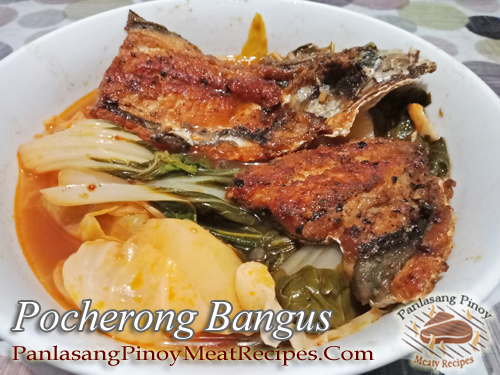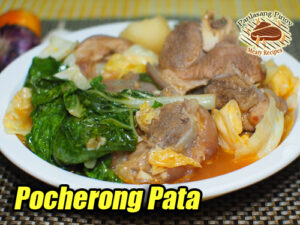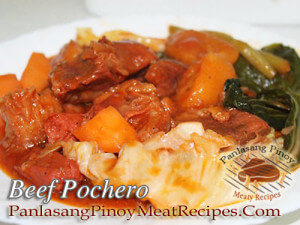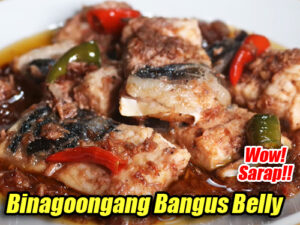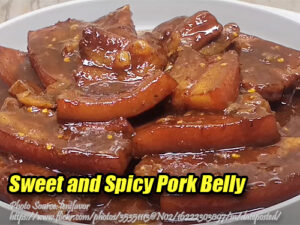A tasty and healthy pochero dish that is easy to prepare and and to cook because you will be using bangus instead of pork. In this recipe, instead of using the ordinary bangus, you need to use boneless bangus or bangus belly. Its because it is more convenient to eat boneless bangus than having to to remove the spiny fish bones while eating this pochero. Other kinds of fish can also be used aside from bangus but be sure you only use fish fillet.
A Nostalgic Twist on a Classic Dish
Growing up, weekends at my grandmother’s house were always something to look forward to. The air would fill with the mouthwatering aromas of traditional Filipino dishes—each one made with love and a sense of history. One dish that I vividly remember is my lola’s version of pochero, but instead of the usual pork, she’d swap it out for bangus, or milkfish. This wasn’t just any fish though; she insisted on using boneless bangus, making it easier to enjoy without worrying about the bones. It wasn’t until years later that I truly appreciated the genius behind this tweak.
This dish, a comforting blend of fish, vegetables, and savory broth, isn’t just about satisfying hunger—it’s about heritage, family, and the memories created around the table. I find myself cooking it now, especially when I long for those lazy weekends spent with family, and each bite brings me back to those simpler times.
Why Use Boneless Bangus?
For many Filipinos, bangus is a staple in the kitchen. However, one thing that can make it less enjoyable is its numerous tiny bones. My grandmother, ever practical, would always use boneless bangus when making this recipe. She believed that the convenience of not having to pick through bones allowed everyone to fully enjoy the meal without interruption.
I also prefer using bangus belly. The belly is rich, tender, and incredibly flavorful—perfect for soaking up the savory tomato broth in this dish. While some people use pork or chicken for pochero, there’s something about the lightness of fish that makes it a great option, especially when you want something a little healthier without sacrificing flavor.
A Healthier Pochero Option
One of the things that make this dish stand out is how light yet filling it is. Traditionally, pochero is made with pork or beef, which gives it a hearty richness, but using bangus changes the game. The fish gives it a more delicate flavor, which pairs perfectly with the sweetness of saba bananas and sweet potatoes.
I remember when my uncle, a bit of a health buff, came over for dinner one night and suggested we lighten up the family recipe by using fish instead of the usual pork. He was right. The fish made the dish feel less heavy, but still deeply satisfying. It’s a perfect dish for when you want something warm and filling, but not overly rich.
The Secret to a Flavorful Broth
If you ask me, the secret to this dish’s success lies in the tomato-based broth. When I sauté the garlic and onions, I make sure to cook them just long enough to release their natural sweetness. Adding tomato paste gives it that deep, rich flavor that ties everything together. I still hear my lola’s voice in my head, reminding me not to rush this part. “Patience, anak,” she’d say, stirring the pot with care.
One tip I picked up from my aunt, who swears by using saba bananas, is that they bring a natural sweetness to the broth that balances the tanginess of the tomato. In fact, I often find that it’s the saba and sweet potatoes that elevate the dish from good to unforgettable. Frying them first, just as my lola did, adds a caramelized layer of flavor that seeps into the broth as it simmers.
A Brief History of Pochero
The dish pochero itself has an interesting backstory. Originally influenced by Spanish cuisine, pochero was traditionally made with pork, chicken, or beef, and it often featured a medley of vegetables. The dish has since evolved, with different regions of the Philippines adding their own twist. In some areas, you might find plantains or chorizo, while in others, fish is used, just like in this recipe.
My lolo used to say that food tells a story, and with pochero, the story is one of adaptation and creativity. It’s a dish that highlights how Filipinos have taken influences from colonization and made it their own, using local ingredients to create something uniquely ours. I love that every family has their own version of pochero, and this one—using milkfish—is ours.
Serving Up Comfort and Tradition
After the broth has simmered and all the ingredients have melded together, you’re left with a comforting bowl of pochero that’s brimming with flavor. The green beans and pechay add a nice crunch, balancing out the tender fish and soft sweet potatoes. And there’s nothing quite like the sight of the golden-fried bangus nestled amongst the vegetables, soaking up all that delicious tomato broth.
Every time I serve this dish, I can’t help but think of family gatherings, of laughter and stories shared over meals. I see my siblings, cousins, and aunts passing the dish around, taking generous spoonfuls. The combination of ingredients brings warmth, not just to the body but to the heart. Even now, cooking this dish in my own kitchen, it feels like a link to the past, a way of keeping those memories alive.
Whether you’re new to Filipino cuisine or a long-time lover of our traditional dishes, this milkfish pochero is one that’s sure to leave an impression. It’s easy to prepare, light yet hearty, and packed with the flavors of home.
Serve it hot with a side of steamed rice, and you’ve got yourself a meal that’s bound to bring back memories—or perhaps, create new ones.
Howto Cook Pocherong Bangus
Ingredients
- 1 kilo bangus boneless about 2 pcs medium size
- 2 pcs saba bananas sliced
- 3 pcs sweet potatoes peeled and quartered
- 3 cloves garlic chopped
- 1 pc onion sliced
- 2 bunch pechay trimmed
- 15 pcs green beans halved
- 3 cups water
- 1 tsp. sugar
- 2 Tbsp. tomato paste
- salt and pepper to taste
- cooking oil
Instructions
How to cook Pocherong Bangus:
- Prepare the bangus by dividing each fish into four pieces. Season with salt and pepper and fry in hot oil until golden brown. Set aside.
- Fry the sweet potatoes and saba bananas too until brown and cooked. Set aside.
- Heat cooking oil in a pan and saute garlic and onion until fragrant. Add in the tomato paste and stir for minute then add water.
- Bring to a boil and add the sweet potatoes, saba bananas, green beans and pechay. Season with salt and pepper and let it simmer for 2 minutes and cover. Then add the fried bangus and simmer for a minute and turn off heat. Serve hot and enjoy!
Notes
Cooking Tips:
Choose Fresh Bangus
For the best flavor, select fresh bangus (milkfish) with clear, bright eyes and firm, shiny skin. If you can, ask your fishmonger to clean and gut the fish for you. This will save time and ensure your fish is ready for cooking.Use a Heavy-Bottomed Pot
A heavy-bottomed pot distributes heat evenly, preventing the ingredients from sticking or burning. This is especially important for dishes like pocherong bangus, where the vegetables and fish need to cook slowly and absorb flavors. Preheat the pot before adding your ingredients to ensure even cooking.Simmer Slowly for Tender Fish
Cook your pocherong bangus over low heat to allow the flavors to meld and the fish to become tender. Avoid high heat, as it can cause the fish to become tough and dry. Gently stir occasionally to prevent sticking and ensure even cooking.
